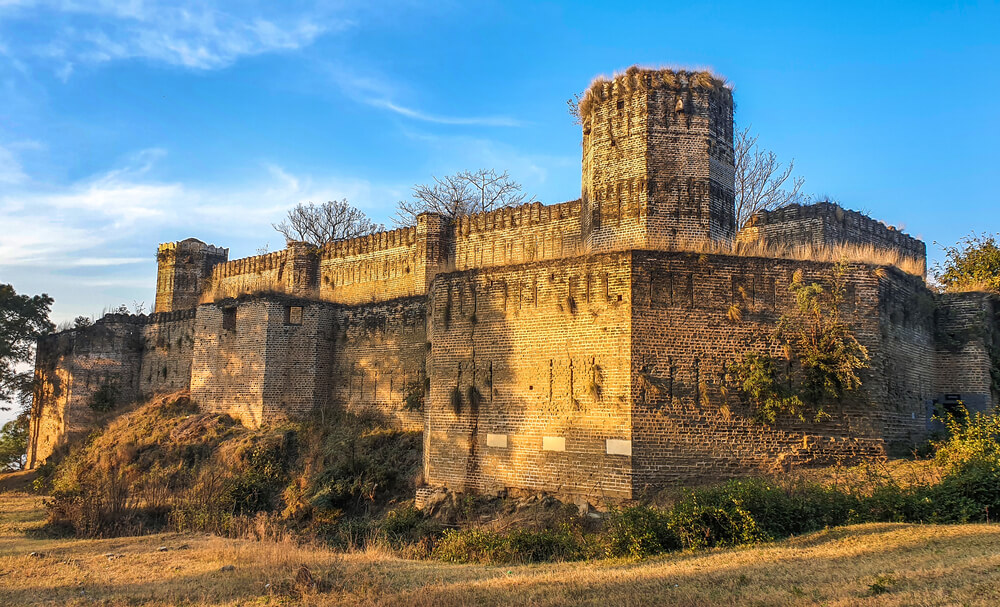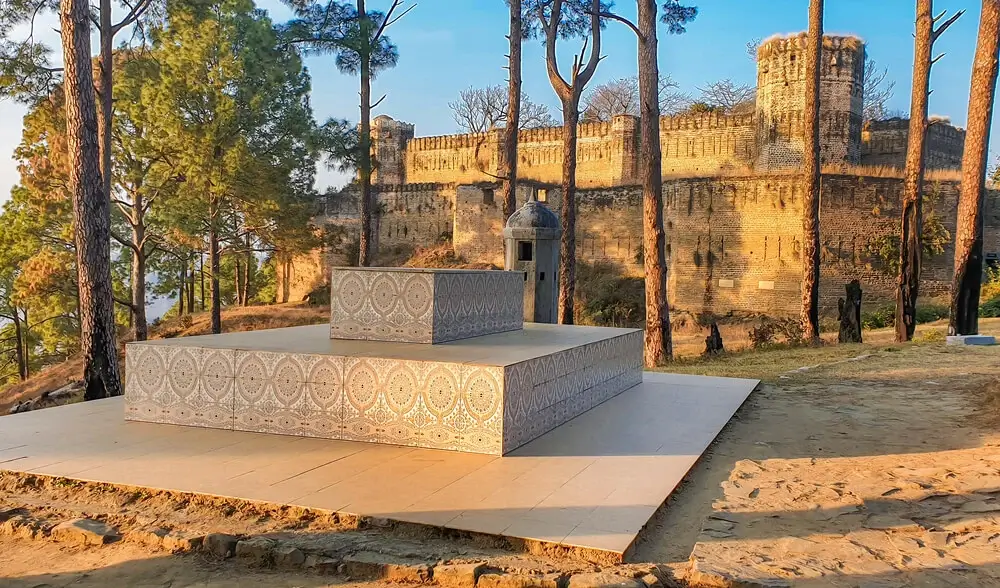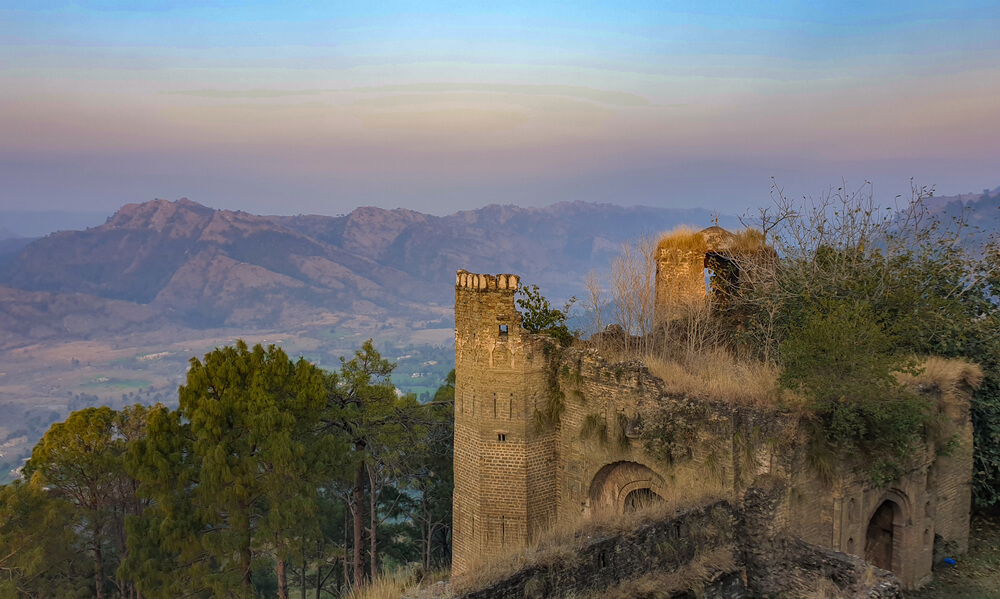Baghsar Fort
Situated in Samahni valley near Bhimber, Azad Kashmir, Pakistan, is an ancient Baghsar fort established by the Mughal emperors for fighting battles. It is a beautiful destination beside the control line between Pakistan and India. Located in Baghsar village, the meaning of Baghsar is ”a land of gardens and water”. It is true because, on your way to Baghsar Fort through Baghsar road, you will witness deep lush green forests spreading in every direction.
History of Baghsar Fort
The history of ancient Baghsar Fort Samahni Valley is very indeterminate as historians have different opinions about who built this stronghold. According to historical facts, the rulers of the Mughal empire constructed the Fort. But an English traveler, Godfrey Thomas Vigne, after going through an extensive tour of Kashmir, said that Dhian Singh, the brother of Maharaja Ghulab Singh Dogra, built the Baghsar Fort. Other people say that the Sikh rulers built this Fort after defeating Raja Sultan Khan, the last ruler of Bhimber, in 1812. Basar Fort played a prominent role in history during Ahmad Shah Abdali, Gulab Singh, and Ranjit Singh.
Baghsar fort also held significant importance in the 1947-48 Kashmir war. The purpose of the Baghsar Fort was to dominate the area and to check on the convoys and routes leading to Kashmir from Punjab. The stationing of the troops was mandatory in the Fort for any required military operation.

The Rulers constructed the Baghsar Fort Samahni Valley keeping in view the tactical importance of the area. Khamba Fort and Mangal Devi Fort were built at later stages to form a series of communication forts and solid military positions in the area.
The Architecture of Baghsar Fort
The design of Baghsar Fort Pakistan depicts the Mughal, Indo-Islamic architectural style. This wartorn Fort has withstood the ravages of time. The rulers constructed the massive structure of the Baghsar Fort Bhimber Azad Kashmir to have a mighty stronghold to fight back against the enemies. The four-storied architecture of the Fort is of coarse granite and stones. The robust structure of the Fort depicts impressive masonry work. The outer circumference comprises a boundary wall and thirty-eight small rooms mainly constructed for the guards and soldiers. Each room consists of a light port and a storage area. There are some apertures in the walls to keep an eye on outside the Fort.
The Interior of the Baghsar Fort consists of a water pond, a darbar hall, and forty-three spacious rooms. The Fort has a total of three entrances. You can enter from either the northern main entrance, the entrance to the inner perimeter, or the southeastern entrance. An observation tower is built in the southeast corner to have a panoramic view of the entire village and to keep an eye on the enemy. There is a firing inlet on the western wall where soldiers used to stand and fire on the opponents. Numerous indentations are on the Fort’s borders to allow archers to fire while staying under cover. Several ventilators are designed in the Fort to prevent suffocation and the proper inlet of light and air. Irrespective of the challenging location of the Fort on the line of control, the Fort’s structure is still intact. But it is desperately in need of a restoration program.
Attractions Inside Baghsar Fort
The ancient and mysterious Baghsar Fort Samahni Valley offers a variety of attractions to its visitors, including a spectacular view of Jammu Kashmir, beautiful mountains, breathtaking Baghsar lake, and many more. Let us talk in detail about these attractions.
Surrounded By Beautiful Mountains
Baghsar fort Azad Kashmir is picturesque, surrounded by beautiful sky-rocketed mountains and a forest of tall pine trees. The aroma of the pine trees has spread in the surrounding air. As the Baghsar Fort Bhimber Azad Kashmir is at a critical destination of the line of control, the mountains are the posting area of the Indian Army from where they do firing.
Tomb of Jahangir
Located inside the Baghsar Fort is The Tomb of Mughal emperor Mirza Nur-ud-din Jahangir. Jahangir is a Persian name meaning ”Conquerer of the World”. According to historical records, the renowned Mughal emperor Jahangir perished in 1627 AD while traveling from Kashmir to Sarai Sadabad, ending the rule of one of the most successful rulers of the Mughal Dynasty. To preserve his body and slow the process of putrefaction, the organs were removed and buried in the Baghsar Fort. The grave is carved from coarse granite, surrounded by pillars, possibly one foot higher, at the corners, and a post at the head of the grave serves as a marker. Later the body was transported to Lahore and buried near the bank of River Ravi in Shahdara. Prince Khurram, the son of Jahangir, also known as Shah Jahan, succeeded his father in the kingdom.

View of Bandala Valley
The beautiful Bandala Valley is in the Bhimber Valley along the River Tawi at some distance of 28 km. It is beautifully present in between the Baghsar mountains and Reech Pahari.
Bandala Valley consists of various ponds, waterfalls, and turquoise streams. People use these pools for swimming and fishing. Natives have grown wheat and corn on the fertile land of this valley. Bandala Valley features wildlife such as jackals, leopards, and beautiful and colorful birds like falcons, eagles, and peacocks. The view of Bandala Valley is undoubtedly a spectacle for the eyes. You can experience the calmness of a serene environment surrounded by deep lush green forests spreading everywhere.
Baghsar Lake
The Baghsar Fort overlooks the breathtaking Baghsar Lake. You can witness the spectacular view of Baghsar lake from the altitude of the Fort. The lake flows 975 above sea level in the Bhimber district of Azad Kashmir.
The Baghsar Lake overlooks the Bandala Valley, a famous tourist attraction. Various local and migratory birds, like ducks and geese, inhabit this lake. Floating on the lake are the beautiful water Lillies.
Portrait of Durga Devi
Durga was a prominent Hindu goddess, and she is one of the most popular and widely respected godheads. She is considered a symbol of protection, motherhood, wars, and strength. An engraved Portrait of Durga Devi is present on the main northern entrance of the Baghsar Fort.

Shahi Darbar
Shahi Darbar is a room situated in the basement of the Fort, which is considered a Royal court, where the rulers used to have meaningful discussions and meetings with the prominent personalities of history. In Shahi Darbar, the rulers listened to the public’s queries. Also, the rulers held court proceedings in the Shahi Darbar (Royal Court).
Water Pond
On the inside of the Fort, a water pond or water reservoir is present. The length of the water pond is 23 feet, the width is 14 feet, and the depth is 28 feet. According to the people of Baghsar village, this water pond provided the source of water supply for the entire Fort.
Mandir Inside Fort
An ancient Mandir or temple is another feature of the Baghsar Fort. It depicts the affiliation of the people of old times for their religion. Erected here are the various sculptures and statues of different gods, which suggests that a Hindu ruler constructed this Fort instead of a Muslim Ruler. The presence of a temple inside the Baghsar Fort indicates that the Fort even existed before the Mughal period.
View of Occupied Kashmir
Standing on the roof of the Baghsar Fort, you will have the privilege to witness the most astonishing and breathtaking view of the Occupied Kashmir valley, surrounded by lush green forests, valleys, and mountains. The best time to pay a visit is in winter to witness the snow-capped mountains in Jammu Kashmir. The presence of the Baghsar Fort Samahni Valley has added grandeur to the entire area.

Baghsar Fort Timings
To visit the Baghsar Fort, you must get permission from the authorities and the Army. It is currently closed to visitors due to its dangerous location. Because of its place beside the line of control between Pakistan and India, the Army usually does not allow visitors, but you can still try to acquire permission.
Location of Baghsar fort Azad Kashmir
Baghsar Fort is in the beautiful Samahni Valley near Bhimber, Pakistan, close to a place known as Baghsar village in Azad Kashmir. Situated in a picturesque and challenging location, the Baghsar Fort is a spectacle of ancient history. It is famous for being located beside the line of control between Pakistan and India. This Fort is popular for containing the grave of the famous Mughal emperor, Jahangir.
Frequently Asked Questions
Who constructed the Baghsar Fort?
According to some scholars, Baghsar Fort is a landmark constructed in the Mughal period on the orders of ruler Jahangir. However, there are conflicting opinions about the establishment of this Fort. An English traveler said that Dhian Singh, Maharaja Ghulab Singh Dogra’s brother built this Fort for defense and fighting battles. But the architecture of the Fort tells another story.
How old is Baghsar fort?
Constructed in the Mughal period in the 16th to 17th centuries is a famous Baghsar Fort. It is among the oldest and most historic forts in Pakistan, which became strategically important during the era of the Mughal emperors.
Conclusion
Baghsar Fort Bhimber Azad Kashmir is a famous tourist attraction many people visit because of the natural beauty and pleasant weather of the Baghsar valley.
This stronghold depicts the glorious history of the rulers of ancient times. People visit this castle due to its deep-rooted history. If you are a sucker for natural beauty and are fond of exploring historical landmarks, this place is a must-visit. You must get permission from the Army and the related authorities before planning a journey to Baghsar Fort Bhimber Azad Kashmir.
